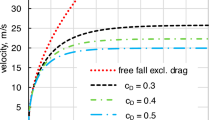Abstract
In the present study, numerical simulations of a high-speed compound unmanned rotorcraft were carried out by employing an unstructured Reynolds-Averaged Navier–Stokes solver. For the simulations, a conceptually designed rotorcraft was used which includes two propellers, a fuselage with main and tail wings and a co-axial rotor. Aerodynamic characteristics of the propulsion components were studied by comparing aerodynamic coefficients with the following modes: hovering, transitional low-speed, high-speed, and maximum flight speed conditions. Furthermore, the effects of the fluid dynamic interactions between the co-axial rotor, propellers, and wings were investigated. Lastly, the impact of ground on the aerodynamic performance on the rotorcraft was studied.










Similar content being viewed by others
Data availability
Data will be made available upon request.
Abbreviations
- \(HCUR\) :
-
High-speed compound unmanned rotorcraft
- \(\mathrm{V}\) :
-
Arbitrary control volume
- \(\mathrm{\delta V}\) :
-
Arbitrary control surface
- \(\overrightarrow{Q}\) :
-
Conservative variable
- \(\overrightarrow{n}\) :
-
Normal vector
- \(\overrightarrow{F}(\overrightarrow{Q})\) :
-
Inviscid flux
- \(\overrightarrow{G}(\overrightarrow{Q})\) :
-
Viscous flux
- \(FDS\) :
-
Flux difference splitting
- \(\mathrm{SA}\) :
-
Spalart–Allmaras
- \(H\) :
-
Height from the ground
- \(\mathrm{D}\) :
-
Diameter of rotor
- \(MPI\) :
-
Message passing interface
- \({C}_{T}\) :
-
Thrust coefficient
- \({C}_{Q}\) :
-
Torque coefficient
- \({C}_{F}\) :
-
Normalized force coefficient
- \({C}_{p}\) :
-
Pressure coefficient
- \(\widehat{{e}_{x}}\) :
-
Unit vector in x-direction
- \(\widehat{{e}_{y}}\) :
-
Unit vector in y-direction
- \(\widehat{{e}_{z}}\) :
-
Unit vector in z-direction
- \(u\) :
-
Velocity in x-direction
- \(\mathrm{v}\) :
-
Velocity in y-direction
- \(w\) :
-
Velocity in z-direction
- \(F\) :
-
Force
- \({S}_{ref}\) :
-
Fuselage wing surface area
- \(\uprho \) :
-
Air density
- \(\mathrm{T}\) :
-
Thrust
- \(Q\) :
-
Torque
- \(\mathrm{A}\) :
-
Area of rotor disk
- \(\mathrm{R}\) :
-
Radius of rotor blade
- \({v}_{tip}\) :
-
Blade tip speed
- \({v}_{free}\) :
-
Freestream velocity
- \(H\) :
-
Distance from the ground to the lower rotor of rotorcraft
References
Roh N, Oh S, Park D (2020) Numerical investigation of forward flight characteristics of multi-ducted fan. J Korean Soc Aeronaut Space Sci 46(2):95–105
Park D, Park SH (2020) A study on prediction methodology to determine the equilibrium tip speed of tip-jet rotor. Korean Society for Comput Fluids Weighting Factor Eng 25(2):65–75
Nagashima T, Nakanishi K (1978) Optimum Performance and Load Sharing of Coaxial Rotor in Hover. J Jpn Soc Aeronaut Space Sci 26(293):325–333
Rober DH (1951) Full-Scale-Tunnel Investigation of the Static Thrust Performance of a Coaxial Helicopter Rotor, NASA TN 2318.
Manikandan R (2013) Hover performance measurements toward understanding aerodynamic interference in coaxial, Tandem, and Tilt Rotors, Proceedings of American Helicopter Society 69th Annual Forum, Phoenix, AZ.
Yoon S, William MC, Thomas HP (2017) Computations of Torque-Balanced Coaxial Rotor Flows. Proceedings of 55th AIAA Aerospace Sciences Meeting, Texas, Grapevine.
Park SH, Kwon OJ (2021) Numerical Study about Aerodynamic Interaction for Coaxial Rotor Blades. Int J Aeronaut Space Sci 22:277–286
Park SH, Kwon OJ (2020) Aerodynamic analysis of high-speed compound unmanned helicopter using an unstructured overset mesh method, Proceedings of the Korean Society for Aeronautical and Space Sciences Fall Conference, Jeju island, Korea.
Park SH, Kwon OJ (2018,) Numerical Study about Aerodynamic Interaction for Coaxial Rotor Blades, Proceedings of the 7th Asian/Australian Rotorcraft Forum, Jeju island, Korea.
Shur ML, Strelets MK, Travin AK, Spalart PR (2000) Turbulence modeling in rotating and curved channels: assessing the spalart-shur correction. AIAA J 38(5):784–792
Jung MS, Kwon OJ (2007) A parallel unstructured hybrid overset mesh technique for unsteady viscous flow simulations, International Conference on Parallel Computational Fluid Dynamics, ParCFD Paper 2007–024.
Nakahashi K, Togashi F, Sharov D (2000) Intergrid-boundary definition method for overset unstructured grid approach. AIAA J 38(11):2077–2084
Karypis G, Kumar V (1998) Multilevel k-way partitioning schemes for irregular graphs. J Parallel Distribution Comput 48(1):95–129
Acknowledgements
This research was funded by the Korea Agency for Infrastructure Technology Advancement (Grant Number N04220134), the Korea Institute of Science and Technology Information (Grant Number C22002), and the Korea Institute of Energy Technology Evaluation and Planning (Grant Number 20213030020200), and the BK21 FOUR Program of the National Research Foundation Korea (NRF) grant funded by the Ministry of Education (MOE) (Grant Number N20220006), and the Agency For Defense Development Grant funded by the Korean Government.
Author information
Authors and Affiliations
Corresponding author
Ethics declarations
Conflict of interest
On behalf of all authors, the corresponding author states that there is no conflict of interest.
Additional information
Publisher's Note
Springer Nature remains neutral with regard to jurisdictional claims in published maps and institutional affiliations.
Appendix A: Definition of Terms
Appendix A: Definition of Terms
1.1 Vortex Intensity / Eddy Current Strength
\(\widehat{{e}_{x}}\), \(\widehat{{e}_{y}}\) and \(\widehat{{e}_{z}}\) refer to unit vectors in x-, y- and z-direction respectively, whereas each of \(u\), \(\mathrm{v}\) and \(\mathrm{w}\) represents flow velocity in each x-, y- and z-direction.
1.2 Dimensionless Force
\(\mathrm{F}\) refers to vertical/horizontal force, whereas each of \({v}_{free}\) and \({S}_{ref}\) represents the freestream velocity and the main wing planform area of the fuselage.
1.3 Thrust and Torque Coefficients
\(\rho \) stands for air density, and each of \(\mathrm{T}\) and \(\mathrm{Q}\) refers to thrust and torque of rotor/propeller. \(\mathrm{A}\) represents the area of the rotor/propeller disk and \(\mathrm{R}\) means the radius of a rotor/propeller blade. \({v}_{tip}\) refers to the speed of the rotor/propeller blade tip.
Rights and permissions
Springer Nature or its licensor (e.g. a society or other partner) holds exclusive rights to this article under a publishing agreement with the author(s) or other rightsholder(s); author self-archiving of the accepted manuscript version of this article is solely governed by the terms of such publishing agreement and applicable law.
About this article
Cite this article
Park, S.H., Kwon, O.J. & Lee, S. Aerodynamic Analysis of High-Speed Compound Unmanned Rotorcraft Using an Unstructured Flow Solver. Int. J. Aeronaut. Space Sci. 24, 1077–1085 (2023). https://doi.org/10.1007/s42405-023-00595-3
Received:
Revised:
Accepted:
Published:
Issue Date:
DOI: https://doi.org/10.1007/s42405-023-00595-3



